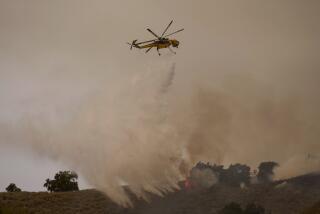Here’s how California can use fire to solve its wildfire problem
If California wants to get out in front of its wildfire problem, scientists have some clear but counterintuitive advice: Start more forest fires.
Decades of research shows that lighting fires under safe conditions not only clears out the dead plants and thick underbrush that fuel many severe wildfires, it also restores a natural process that once kept forests healthy and resilient.
It can be tricky to pull off because all fires, whether natural or intentional, are inherently dangerous and smoky. Even so, experts say the benefits far outweigh the risks.
California’s overgrown forests came under scrutiny when President Trump blamed them for the state’s recent fires and called for more aggressive management.
Experts say the diagnosis was misplaced; the fires in both Paradise and Southern California drew their deadly power from extreme weather conditions exacerbated by climate change, not from the buildup of dense trees and brush.
Nevertheless, scientists and land managers agree on the importance of reducing flammable fuel in California’s vast conifer forests. And they say that fire is the best tool for the job.
“We really have to understand that what’s really needed on the landscape is more fire, not less,” said Kelly Martin, the fire chief of Yosemite National Park.
Some fires will happen no matter what, scientists say. The question is: Do we want fires we can control, or fires we can’t?
::
Until the 1800s, when settlers flooded into California, many parts of the state experienced far more wildfire than they do today. Natural fires burned unimpeded, and Native Americans lit blazes to reduce future risks and boost the growth of desirable plants, as they had done for thousands of years. The state’s ecosystems evolved not just to tolerate burning, but to depend on it.
“California landscapes were really truly born and bred of fire,” Martin said.
Then the federal government intervened. After several massive wildfires ripped through the West in the early 1900s, the newly formed U.S. Forest Service began extinguishing flames as quickly as possible. Managers believed that suppressing fires protected both communities and forests, Martin said. And for decades, it did.
But over time, the plan backfired. That was especially true in conifer forests, which used to burn every five to 20 years and grew denser with each missed cycle.
Then came drought, tree-killing beetles and climate change — plus a booming population that kept expanding into forested areas.
Californians are all too familiar with the consequences: catastrophic wildfires that are nearly impossible to contain.
“If you want to really, fully restore the forest, you have to get fire back in there,” said Malcolm North, a research scientist at the U.S. Forest Service’s Pacific Southwest Research Station in Davis, Calif.
If you want to really, fully restore the forest, you have to get fire back in there.
— Malcolm North, a research scientist at the U.S. Forest Service’s Pacific Southwest Research Station
Beyond removing saplings and pine duff, fire creates natural variability in the spacing of trees, he said. It typically leaves denser stands in wetter places and creates gaps in dryer areas that prevent flames from spreading.
“That’s one of the features which made forests so resilient to fire and drought,” he said.
Fire also plays a critical role in breaking down material on the forest floor and recycling nutrients.
Except near communities, the goal of prescribed burns is not to prevent future fires, but to allow more wildfires to burn safely, North said.
The 2013 Rim fire was a prime example.
It started with a runaway campfire on National Forest land east of Groveland, Calif., and quickly metastasized. But then it spread into nearby Yosemite National Park, where for decades Martin and her predecessors had been lighting prescribed fires and allowing natural ones to burn.
When the Rim fire hit previously treated areas, it suddenly became tamer. It dropped from the canopy back down to the ground, burned less intensely, and didn’t require much suppression, Martin said.
The controlled burns also protected staff buildings near the Hodgdon Meadow Campground. “We didn’t lose any homes,” she said.
::
Despite its effectiveness, prescribed burning remains vastly underutilized in California and across the West.
“You’ve got a whole bunch of things which make it difficult,” North said.
Like smoke, which is unhealthy to breathe, particularly for those with asthma and other health conditions.
Then there are the lives and property at risk in the roughly 1% of fires that escape. In one tragic case, a prescribed fire just west of Denver destroyed about two dozen homes and killed three people.
Such accidents are rare, however, and managers can minimize the public’s exposure by lighting fires under favorable weather conditions.
“Yes, there’s some risk. Yes, there’s some smoke. But what’s the trade-off?” said Jeff Kane, a fire ecologist at Humboldt State University.
Yes, there’s some risk. Yes, there’s some smoke. But what’s the trade-off?
— Jeff Kane, a fire ecologist at Humboldt State University
Some California forests are so clogged with overgrowth that it’s unsafe to introduce fire without first pulling out some of the smaller trees and shrubs.
“In many cases, particularly in the Sierra Nevada, 85% to 95% of the forest is in an extremely explosive condition,” North said. Thinning gives managers a toehold.
Outgoing Secretary of the Interior Ryan Zinke endorsed both prescribed burning and thinning in a recent op-ed on CNN advocating for more aggressive forest management. However, he has more often emphasized the need to cut trees, arguing that the additional logging will benefit rural economies.
“Logs typically come out of the forest in one of two ways: they are either harvested as timber to sustainably improve the health and resiliency of the forest (while creating jobs), or they are burned to the ground,” he wrote.
But scientists say logging rarely reduces fire risk — unless it helps subsidize the cost of effective thinning.
The large trees that make money for logging companies “are very fire-resistant and they are not contributing to the fire intensity,” North said. The real culprits are the shrubs and small trees that serve as “ladder fuels” because they lift flames from the forest floor to the canopy. And these have little commercial value.
North’s research found that thinning costs about 3.5 times more than controlled burning and will not, on its own, provide the full ecological benefits of fire or make a dent in the millions of rugged acres that need treatment.
“You cannot thin your way out of the problem,” he said.
::
California has warmed to the idea that it must fight fire with fire.
In 2015, a coalition of state and federal land management agencies, local air quality districts, tribes and nonprofit organizations came together to reduce barriers to prescribed burning. They are working to make controlled burns easier to coordinate and smoke easier to track.
The momentum picked up in May, when Gov. Brown created a forest management task force to identify windows of opportunity for prescribed burns and streamline the permitting process. In September, Brown signed a bill aimed at expanding the use of prescribed fires by, among other things, creating ways for landowners and agencies to share costs and liability.
“I kind of had to pinch myself,” said Craig Thomas, the recently retired conservation director of Sierra Forest Legacy. “I love being in California because we can have that complicated conversation. We need to stop the bad fire and dramatically increase the good fire.”
We really have to understand that what’s really needed on the landscape is more fire, not less.
— Kelly Martin, fire chief of Yosemite National Park
But other hurdles remain, including a lack of firefighters, equipment and funding, according to research by Courtney Schultz, a forest policy expert at Colorado State University. Fire suppression has become such a monumental task that it often occupies all available personnel and funds, leaving nothing left for things like prescribed burning.
The U.S. Forest Service will get some help starting in 2020, thanks to congressional action that will free up funds for forest management.
California has already given the state’s Department of Forestry and Fire Protection, known as Cal Fire, money for six crews dedicated solely to prescribed fire. The department also got funds to train prescribed-burn fire bosses throughout the state.
“We are rebuilding a program that has been dormant for more than a decade,” said Thom Porter, Cal Fire’s chief of strategic planning.
Both state and federal forest managers hope to ramp up prescribed fires in coming years. And Martin said they have their work cut out for them.
“We are going to have to go big in order to meet these big fires in the future,” she said.







